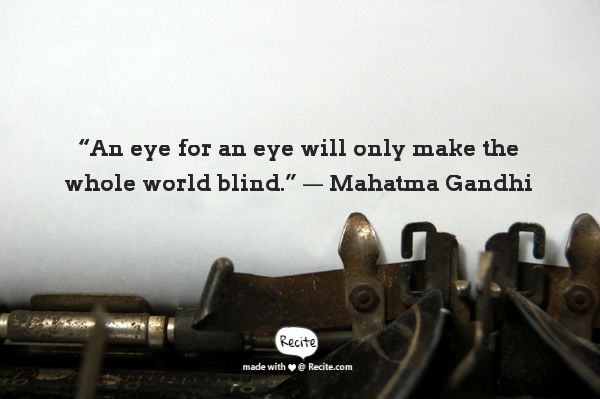

As with blasphemy or lèse-majesté (crimes against a god or a monarch), crimes against one's social betters were punished more severely. Babylonian law put a limit on such actions, restricting the retribution to be no worse than the crime, as long as victim and offender occupied the same status in society. The retribution might be worse than the crime, perhaps even death. If it is surmised that in societies not bound by the rule of law, if a person was hurt, then the injured person (or their relative) would take vengeful retribution on the person who caused the injury. The principle is found in Babylonian Law.
AN EYE FOR AN EYE GANDHI QUOTE CODE
The earliest known use of the principle appears in the Code of Hammurabi, which predates the Hebrew Bible. This body was the state in one of its earliest forms. Despite having been replaced with newer modes of legal theory, lex talionis systems served a critical purpose in the development of social systems-the establishment of a body whose purpose was to enact the retaliation and ensure that this was the only punishment. Various ideas regarding the origins of lex talionis exist, but a common one is that it developed as early civilizations grew and a less well-established system for retribution of wrongs, feuds and vendettas, threatened the social fabric. The exact Latin (lex talionis) to English translation of this phrase is "The law of retaliation." The root principle of this law is to provide equitable retribution. The meaning of the principle Eye for an Eye is that a person who has been injured by another person returns the offending action to the originator in compensation, or that an authority does so on behalf of the injured person. In the modern tort law system, this has been extended to translate non-economic losses into money as well. Under the English Common Law, successful plaintiffs were entitled to repayment equal to their loss (in monetary terms). The Anglo-Saxon legal code substituted payment of wergild for direct retribution: a particular person's life had a fixed value, derived from his social position any homicide was compensated by paying the appropriate wergild, regardless of intent. Conversely, the Twelve Tables of Rome merely prescribed particular penalties for particular crimes.

In that case, the rule was that punishment must be exactly equal to the crime. The simplest example is the "eye for an eye" principle. For example, if a person caused the death of another person, the killer would be put to death. In the famous legal code written by Hammurabi, the principle of exact reciprocity is very clearly used. Legal codes following the principle of lex talionis have one thing in common: prescribed 'fitting' counter punishment for a felony. The most common expression of lex talionis is "an eye for an eye", but other interpretations have been given as well. Some propose that this was at least in part intended to prevent excessive punishment at the hands of either an avenging private party or the state.

The term lex talionis does not always and only refer to literal eye-for-an-eye codes of justice (see rather mirror punishment) but applies to the broader class of legal systems that specifically formulate penalties for specific crimes, which are thought to be fitting in their severity.


 0 kommentar(er)
0 kommentar(er)
